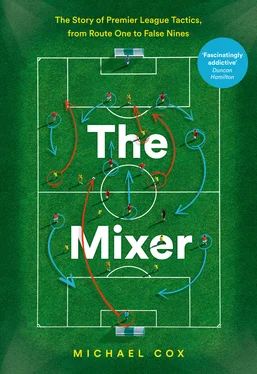1 ...7 8 9 11 12 13 ...25 Keegan, on the other hand, appointed his old Liverpool teammate Terry McDermott. Not only did McDermott, like Keegan, boast absolutely no previous coaching experience, he also had no coaching badges, had no intention of becoming a coach and had recently been spotted manning a burger van at a racecourse. ‘He’s not here in any capacity other than to help the atmosphere of the club,’ said Keegan, who personally paid for McDermott’s employment from his own salary. McDermott concentrated on taking players aside after training and improving a specific part of their technique. Blackburn had an assistant manager who took every training session and focused upon the collective, while Newcastle’s assistant manager didn’t take any sessions and focused upon individuals. Ultimately, that was a perfect microcosm of the sides’ approaches.
Blackburn were new kids on the block. Before the Premier League era they hadn’t featured in the top flight since before England won the World Cup, even dropping into the third tier during the 1970s. Their sudden rise owed much to the wealth of Jack Walker, a Blackburn-born millionaire who had inherited Walkersteel, a scrap-metal business, from his father and turned it into the largest steel stockholder in Britain. His munificence explains how second-tier Blackburn managed to attract Dalglish, already a multiple title winner as both player and manager with Liverpool, and how, having won promotion in time for the Premier League’s inaugural campaign, they promptly finished fourth, second and then first. Dalglish insists Blackburn’s title wasn’t solely about Walker’s millions, with some justification – although the signings of centre-forwards Alan Shearer and Chris Sutton both broke the record for the highest transfer fee paid by a British club. Both were old-fashioned number 9s who thrived on crosses, in keeping with Blackburn’s simple footballing approach, and they quickly became nicknamed ‘the SAS’ because of their ruthlessness in front of goal. They contributed 49 goals during Blackburn’s title-winning campaign and remain arguably the Premier League’s most famous strike partnership. Their off-field relationship, however, was less successful.
When Shearer signed for Blackburn in 1992 he was befriended by new strike partner Mike Newell on a pre-season tour of Scotland, and as he waited for his wife to move to Lancashire he spent plenty of time at Newell’s house. It was a classic footballing friendship; they played golf together, they travelled to training together, they were roommates on away trips and their great relationship continued on the pitch. Newell had previously been an out-and-out striker, but after Blackburn recruited the country’s hottest young goalscorer, Newell adjusted and played a deeper, supporting role. ‘He was an ideal striking partner, so unselfish and willing to cover every blade of grass,’ Shearer said. ‘Sometimes he gave the impression he would rather lay on goals for me than score himself … with him just behind the attack, opposition teams would push a defender out to mark him and that would give me more room in which to operate. He was a big reason for my success.’ Shearer won the Golden Boot in three of the first five Premier League seasons, and finished on a record 260 Premier League goals.
The arrival of Sutton, who had only recently become a permanent centre-forward at Norwich having often played in defence, changed things in two ways. Most obviously, Newell was the major victim and started just twice in Blackburn’s title-winning season. Meanwhile, Sutton stole Shearer’s thunder, taking his status as Britain’s most expensive player. He briefly became Blackburn’s highest-paid player, too, although Blackburn immediately handed Shearer a rise to reflect his seniority. ‘Suddenly, Alan was being asked to play with a guy who wanted to score as many goals as him,’ said Le Saux. ‘That was when I saw a side of Alan that I wasn’t keen on … Alan knew his relationship with Mike revolved around himself, and neither he nor Mike reacted well when Chris broke up their partnership.’
Sutton, a fearsome striker but a sensitive character who occasionally lacked confidence, later recalled the ‘lack of warmth’ from Shearer, blaming his friendship with Newell. When Sutton hit a hat-trick in a 4–0 victory over Coventry in Blackburn’s third game of the season, he was upset when Shearer didn’t celebrate with him. Publically, Dalglish insisted there were no problems between his two star strikers, but with Blackburn’s attacking play no longer based entirely around him, Shearer wasn’t best pleased.
It was nevertheless a stunningly effective strike partnership. Blackburn’s opening goal of their title-winning season, away at Southampton, set the scene. Captain Tim Sherwood lofted a long pass into the box, Sutton nodded the ball down, and Shearer smashed the ball home. Simple, but effective. Blackburn now had two strikers in the penalty box whenever possible, and without Newell playing the link role, focused heavily on getting the ball wide and sending in a stream of crosses.
As much as the SAS, Blackburn’s football was defined by their two wingers. Right-sided Stuart Ripley and left-sided Jason Wilcox were classic, touchline-hugging dribblers who sprinted to the byline and hung crosses into the box. As Dalglish put it, they were ‘proper wingers, not wide midfielders’. Nor were they goalscorers like Manchester United’s pairing of Ryan Giggs and Andrei Kanchelskis, who were capable of reaching double figures in a season, but rather facilitators, assisters and, unlike many wingers, extremely hard workers without the ball. Blackburn’s central midfielders, Sherwood and Mark Atkins (who played the majority of the season before being replaced by Batty, who returned from injury for the final five games), pushed forward in turn, the other protecting the defence. Sherwood was better in possession, Atkins cool in front of goal – the best finisher at the club, according to Dalglish – but they seldom played through-balls and instead passed calmly out wide. It was a system ‘designed for a centre-forward to score goals’, as Shearer said.
Critics claimed Blackburn’s approach play was too predictable, but opponents found it difficult to stop, partly because of the cohesive interplay stemming from the training sessions directed by Harford, whose favourite phrase was simply ‘If it ain’t broke, don’t fix it.’ Blackburn’s training ground, incidentally, was astonishingly basic: a patch of land covered in dog mess, with no changing facilities. The players drove to Ewood Park, got changed, then drove to training. Most problematically, the training ground was adjacent to a cemetery, so sessions were frequently interrupted out of respect when a hearse slowly crept up the driveway. Harford’s ‘pattern of play’ sessions involved Blackburn lining up in their 4–4–2 formation on the training pitch, and practising their build-up play. Their passing and movement was very structured and always ended with Blackburn working the ball into crossing positions.
There were three major approaches. Ideally, Blackburn found a winger in a position to dribble forward, their most obvious route to goal. If not, the wingers were instructed to come short, bringing the opposition full-back up the pitch and allowing Shearer or Sutton to drift wide into space. Shearer implored Sutton to do the majority of the running so he could remain in the penalty box, but actually became an excellent crosser himself, ending the campaign as Blackburn’s most prolific assister as well as their top scorer. Finally, Dalglish and Harford recognised that full-backs were the players with the most time on the ball when 4–4–2 played 4–4–2, invariably the battle of formations during this period. Right-back Henning Berg was more of a converted centre-back, so there was a huge emphasis on left-back Le Saux to push forward, and he had a fine relationship with Wilcox and Shearer, supplying many key assists, most notably hanging a cross up for Shearer to nod home in Blackburn’s penultimate match of the campaign, a 1–0 victory over Newcastle.
Читать дальше












